Andrii Yalanskyi
REIT Performance
In March the REIT sector recovered some of its losses from the first two months of the year, but still closed out Q1 2024 in the red. Equity REITs averaged a +3.26% total return in March and outperformed the broader market. The NASDAQ (+1.8%), Dow Jones Industrial Average (+2.2%) and S&P 500 (+3.2%) all saw solid gains in March albeit smaller gains than the average REITs. The market cap weighted Vanguard Real Estate ETF (VNQ) fell short of the average REIT in March (+1.96% vs. 3.26%) but has seen smaller losses year to date (-1.28% vs. -2.87%). The spread between the 2024 FFO multiples of large cap REITs (16.9x) and small cap REITs (12.5x) remained flat in March as multiples expanded 0.1 turns for both large caps and small caps. Investors currently need to pay an average of 38.5% more for each dollar of FFO from large cap REITs relative to small cap REITs. In this monthly publication, I will provide REIT data on numerous metrics to help readers identify which property types and individual securities currently offer the best opportunities to achieve their investment goals.
Source: Graph by Simon Bowler of 2nd Market Capital, Data compiled from S&P Global Market Intelligence LLC. See important notes and disclosures at the end of this article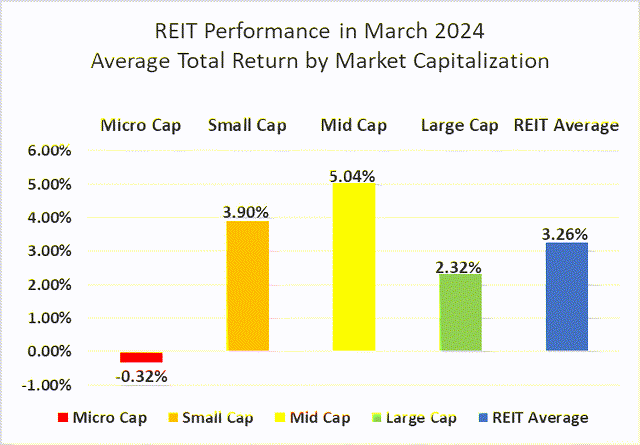
Mid cap (+5.04%), small cap (3.90%) and large cap REITs (+2.32%) finished March in the black, whereas micro caps (-0.32%) finished in negative territory again in March. Large caps have outperformed small caps by 238 basis points through the first quarter of 2024.
Source: Graph by Simon Bowler of 2nd Market Capital, Data compiled from S&P Global Market Intelligence LLC. See important notes and disclosures at the end of this article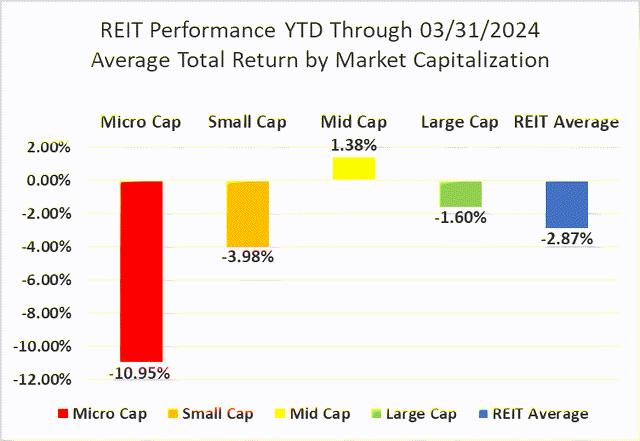
14 out of 18 Property Types Yielded Positive Total Returns in March
78% percent of REIT property types averaged a positive total return in March. There was a 20.1% total return spread between the best and worst performing property types. Advertising (+13.03%) was the leading property type in March, driven by OUTFRONT Media (OUT) (+16.84%) which had the 6 th highest total return among REITs in March.
Infrastructure (-7.07%) badly underperformed all other property types yet again in March. CorEnergy Infrastructure Trust (OTCPK:CORRQ) (-63.00%) continued to freefall since the common shares will be wiped out in bankruptcy.
Source: Table by Simon Bowler of 2nd Market Capital, Data compiled from S&P Global Market Intelligence LLC. See important notes and disclosures at the end of this article 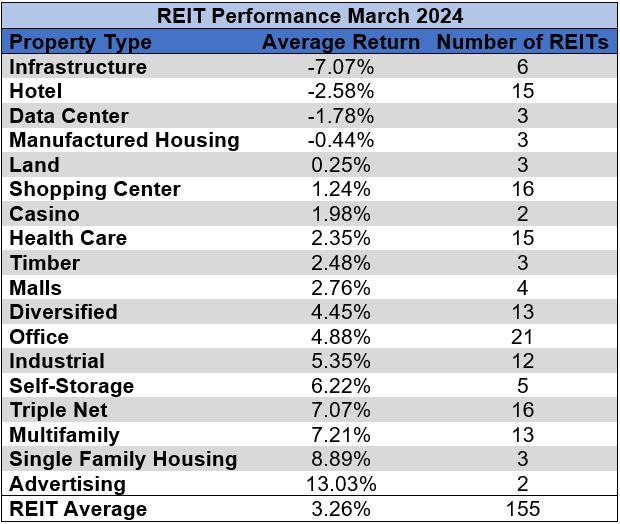
Infrastructure (-17.48%) and Land (-9.50%) have seen the worst average total returns year to date. Advertising (+18.20%) and Single Family Housing (+9.85%) outperformed all other REIT property types in the first quarter of the year.
Source: Table by Simon Bowler of 2nd Market Capital, Data compiled from S&P Global Market Intelligence LLC. See important notes and disclosures at the end of this article 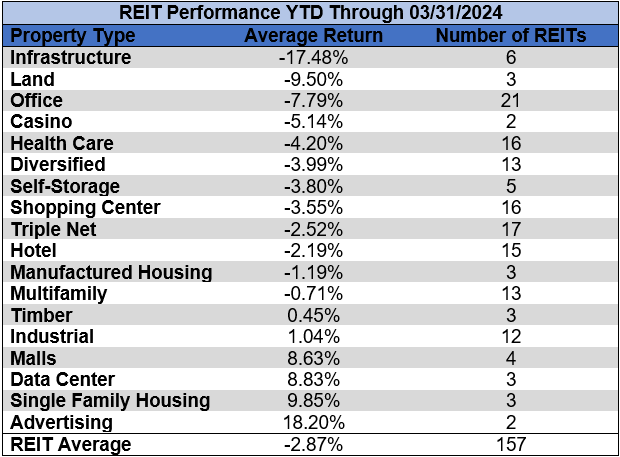
The REIT sector as a whole saw the average P/FFO (2024Y) increase 0.5 turns in March from 12.9x up to 13.4x. 61.1% of property types averaged multiple expansion, 27.8% saw multiple contraction and 11.1% held a steady multiple. Land (29.6x), Data Centers (25.5x), Single Family Housing (20.1x), Timber (19.8x) and Manufactured Housing (19.1x) currently trade at the highest average multiples among REIT property types. Office (8.3x), Malls (8.5x) and Hotels (8.8x) are the only property types that average single digit FFO multiples.
Source: Table by Simon Bowler of 2nd Market Capital, Data compiled from S&P Global Market Intelligence LLC. See important notes and disclosures at the end of this article 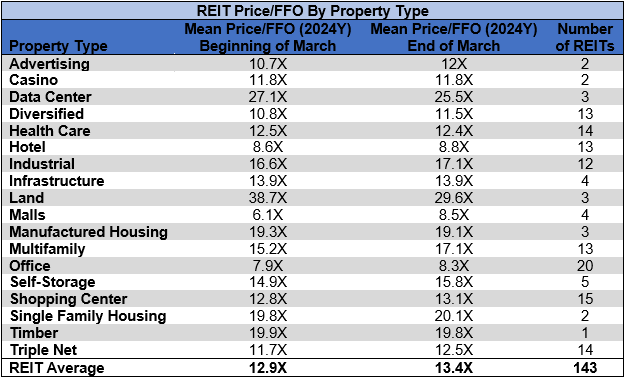
Performance of Individual Securities
Generation Income Properties (GIPR) (+22.84%) bounced back from a brutal February (-23.46%) to finish the first quarter essentially flat (-0.06%). As a micro-cap REIT that has posted negative FFO/share in 6 of the past 10 quarters, there has been elevated volatility of both earnings and share price relative to many of their triple net REIT peers.
CorEnergy Infrastructure Trust (-63.00%) continued to freefall throughout March due to the chapter 11 bankruptcy filing announcement on February 25th. Since common shareholders will receive no proceeds from the upcoming bankruptcy, the stock has now plummeted to approximately $0.01/share and finished Q1 with a -97.11% total return.
78.06% of REITs had a positive total return in March. During the first quarter of 2023 the average REIT had a -1.23% return. The REIT sector kicked off the first quarter of 2024 with a fairly similar -2.87% total return.
Source: Table by Simon Bowler of 2nd Market Capital, Data compiled from S&P Global Market Intelligence LLC. See important notes and disclosures at the end of this article Source: Table by Simon Bowler of 2nd Market Capital, Data compiled from S&P Global Market Intelligence LLC. See important notes and disclosures at the end of this article Source: Table by Simon Bowler of 2nd Market Capital, Data compiled from S&P Global Market Intelligence LLC. See important notes and disclosures at the end of this article 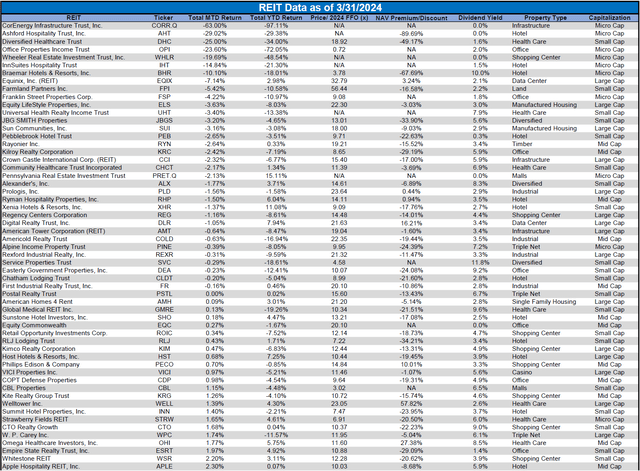
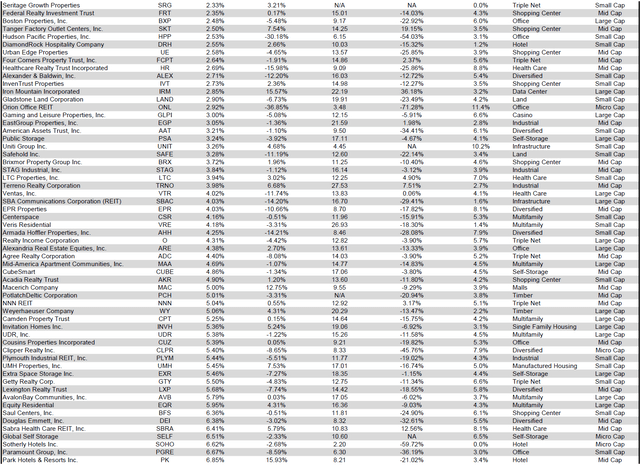
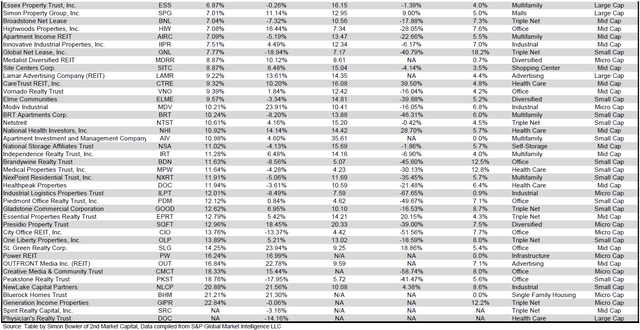
For the convenience of reading this table in a larger font, the table above is available as a PDF as well.
Dividend Yield
Dividend yield is an important component of a REIT’s total return. The particularly high dividend yields of the REIT sector are, for many investors, the primary reason for investment in this sector. As many REITs are currently trading at share prices well below their NAV, yields are currently quite high for many REITs within the sector. Although a particularly high yield for a REIT may sometimes reflect a disproportionately high risk, there exist opportunities in some cases to capitalize on dividend yields that are sufficiently attractive to justify the underlying risks of the investment. I have included below a table ranking equity REITs from highest dividend yield (as of 03/31/2024) to lowest dividend yield.
Source: Table by Simon Bowler of 2nd Market Capital, Data compiled from S&P Global Market Intelligence LLC. See important notes and disclosures at the end of this article Source: Table by Simon Bowler of 2nd Market Capital, Data compiled from S&P Global Market Intelligence LLC. See important notes and disclosures at the end of this article Source: Table by Simon Bowler of 2nd Market Capital, Data compiled from S&P Global Market Intelligence LLC. See important notes and disclosures at the end of this article Source: Table by Simon Bowler of 2nd Market Capital, Data compiled from S&P Global Market Intelligence LLC. See important notes and disclosures at the end of this article 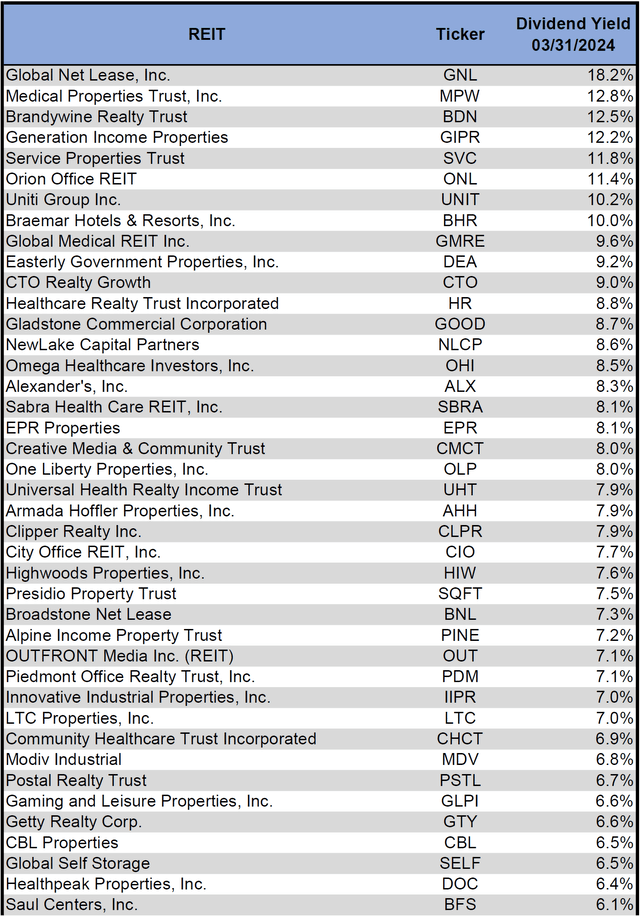
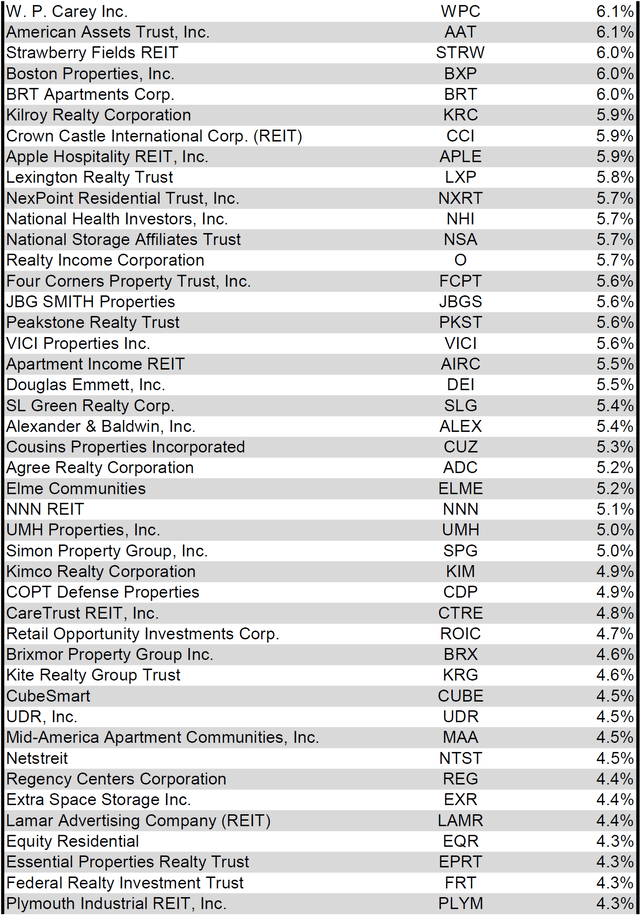
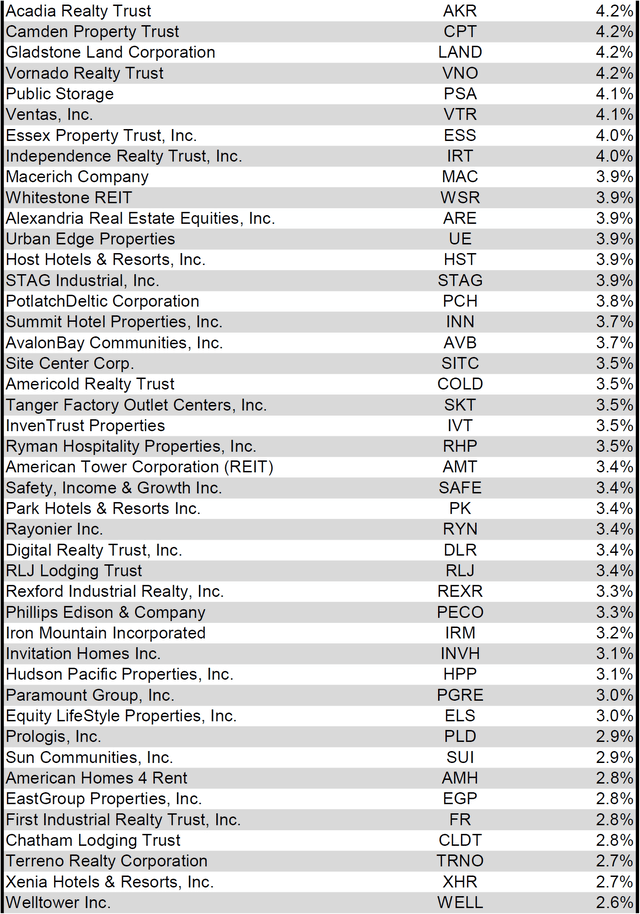
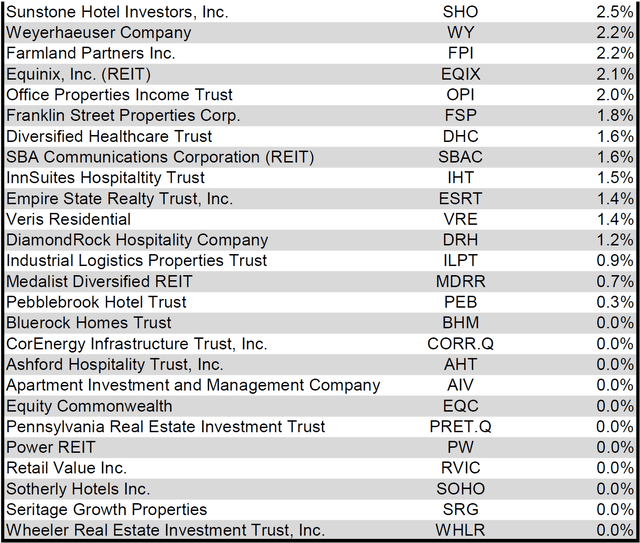
For the convenience of reading this table in a larger font, the table above is available as a PDF as well.
Although a REIT’s decision regarding whether to pay a quarterly dividend or a monthly dividend does not reflect on the quality of the company’s fundamentals or operations, a monthly dividend allows for a smoother cash flow to the investor. Below is a list of equity REITs that pay monthly dividends ranked from highest yield to lowest yield.
Source: Table by Simon Bowler of 2nd Market Capital, Data compiled from S&P Global Market Intelligence LLC. See important notes and disclosures at the end of this article 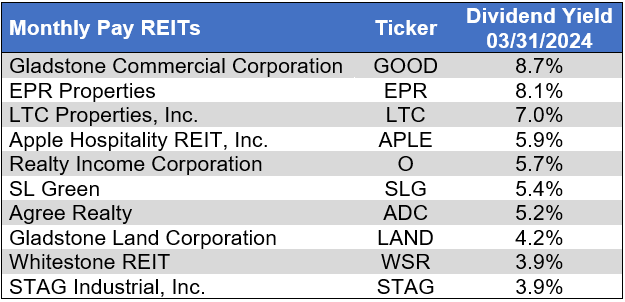
Valuation
REIT Premium/Discount to NAV by Property Type
Below is a downloadable data table, which ranks REITs within each property type from the largest discount to the largest premium to NAV. The consensus NAV used for this table is the average of analyst NAV estimates for each REIT. Both the NAV and the share price will change over time, so I will continue to include this table in upcoming issues of The State of REITs with updated consensus NAV estimates for each REIT for which such an estimate is available.
Source: Table by Simon Bowler of 2nd Market Capital, Data compiled from S&P Global Market Intelligence LLC. See important notes and disclosures at the end of this article Source: Table by Simon Bowler of 2nd Market Capital, Data compiled from S&P Global Market Intelligence LLC. See important notes and disclosures at the end of this article Source: Table by Simon Bowler of 2nd Market Capital, Data compiled from S&P Global Market Intelligence LLC. See important notes and disclosures at the end of this article Source: Table by Simon Bowler of 2nd Market Capital, Data compiled from S&P Global Market Intelligence LLC. See important notes and disclosures at the end of this article 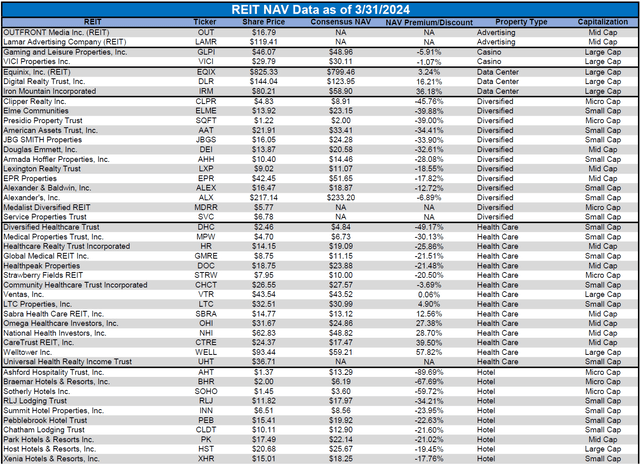
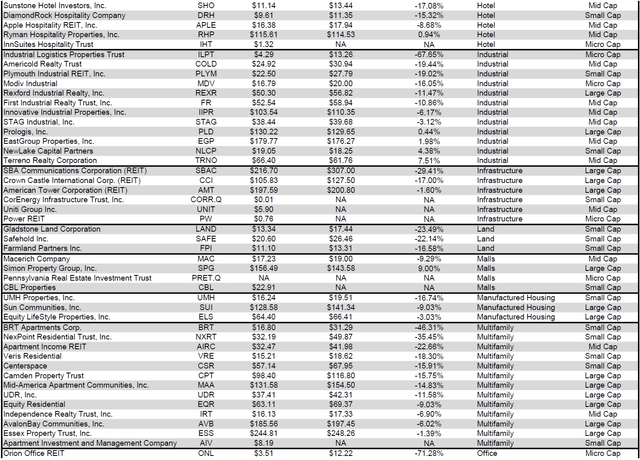
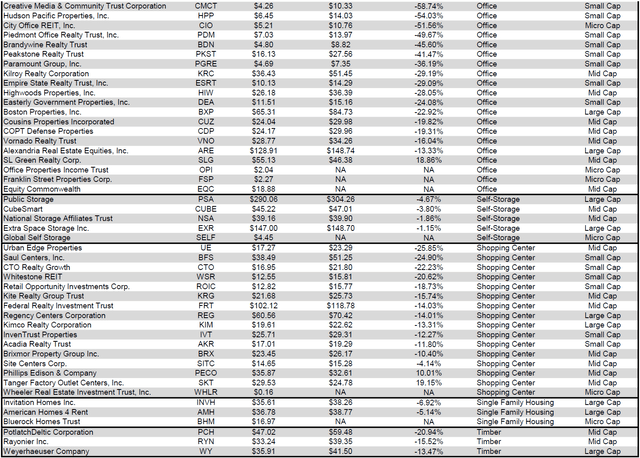

For the convenience of reading this table in a larger font, the table above is available as a PDF as well.
Takeaway
The large cap REIT premium (relative to small cap REITs) narrowed slightly in March and investors are now paying on average about 35% more for each dollar of 2024 FFO/share to buy large cap REITs than small cap REITs (16.9x/12.5x – 1 = 35.2%). As can be seen in the table below, there is presently a strong positive correlation between market cap and FFO multiple.
Source: Table by Simon Bowler of 2nd Market Capital, Data compiled from S&P Global Market Intelligence LLC. See important notes and disclosures at the end of this article 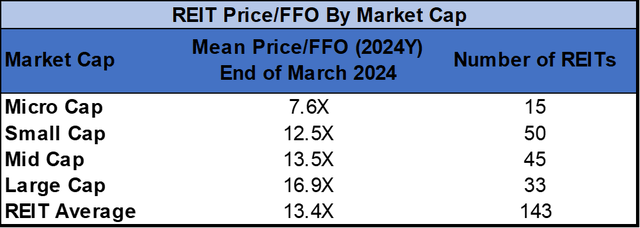
The table below shows the average NAV premium/discount of REITs of each market cap bucket. This data, much like the data for price/FFO, shows a strong, positive correlation between market cap and Price/NAV. The average large cap REIT (-4.17%) and mid cap REIT (-6.72%) trade at single-digit discounts to NAV. Small cap REITs (-23.75%) trade at just over 3/4 of NAV and micro caps on average trade at less than half of their respective NAVs (-51.00%).
Source: Table by Simon Bowler of 2nd Market Capital, Data compiled from S&P Global Market Intelligence LLC. See important notes and disclosures at the end of this article 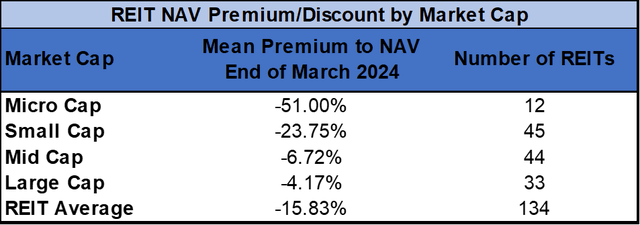
Bankruptcy filings again increased month-over-month in March but have now decreased year-over-year in each of the first three months of 2024. As of the end of Q1, 2024 bankruptcy filings are down 18.9% compared to the same period of 2023. There were 4.1% fewer bankruptcy filings in Q1 2024 than the average number of Q1 filings since 2010.
S&P Global Market Intelligence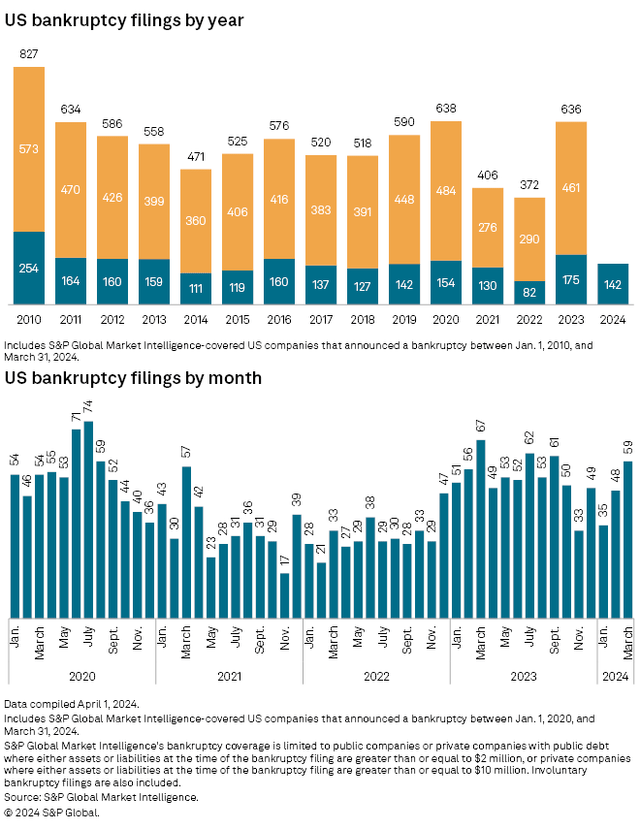
8 REITs announced dividend hikes in March, 6 of which are quarterly and 2 of which are monthly. This brings the total to 35 REITs that raised their dividends in Q1. The largest March increase was from InvenTrust Properties (IVT) with a +4.9% hike followed by +3.6% from CareTrust REIT (CTRE) and +3.1% from Whitestone REIT (WSR).
S&P Global Market Intelligence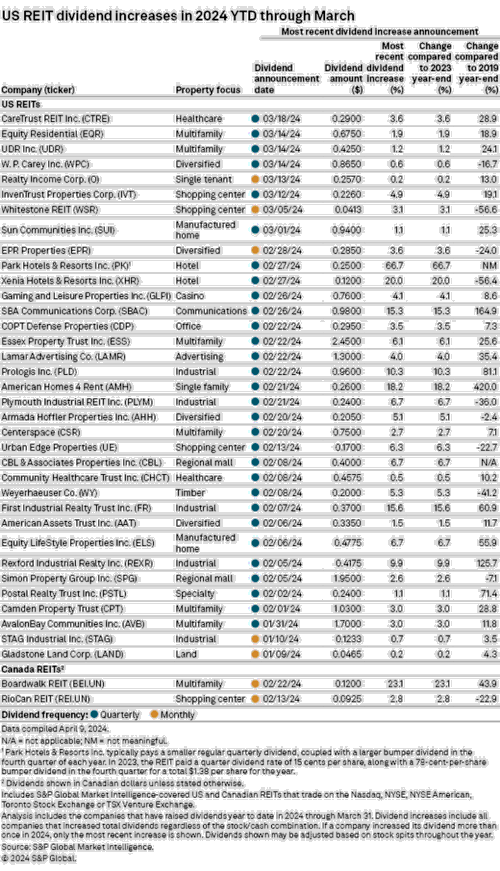
Office is the property type that has arguably been the hardest hit over the past 5 years due to the pandemic era government-imposed lockdown and the resulting acceleration of the work from home trend. The office REITs that have seen the biggest FFO/share declines since Q4 2019 are Hudson Pacific Properties (HPP) (-74.5%), Franklin Street Properties (FSP) (-72.0%) and SL Green Realty (SLG) (-61.3%).
S&P Global Market Intelligence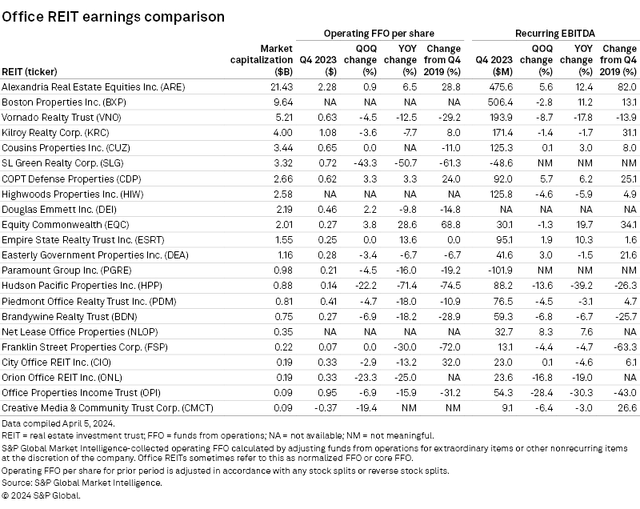
A great illustration of the fact that not all office properties are the same is Alexandria Real Estate Equities (ARE). Their portfolio of high-demand life science properties is dramatically outperforming non-medical office properties, with operating FFO/share growth of +28.8% from Q4 2019 to Q4 2024 and a remarkable +82% increase in recurring EBITDA.
Source: Table by Simon Bowler of 2nd Market Capital, Data compiled from S&P Global Market Intelligence LLC. See important notes and disclosures at the end of this article 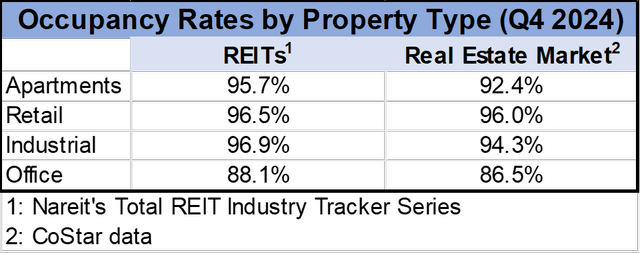
REIT share prices have been impacted by a negative perception of fundamentals in the commercial real estate sector as a whole, but a comparison of overall occupancy rates by property type vs. REIT occupancy rates for the same property types shows that REIT properties are clearly outperforming the broader commercial real estate sector. REITs typically own higher quality assets, which helps to fuel this fundamental outperformance. There are certainly numerous risks within the real estate sector, but the magnitude of some of these property level risks is lower for many REITs due to their superior portfolios.
Editor’s Note: This article discusses one or more securities that do not trade on a major U.S. exchange. Please be aware of the risks associated with these stocks.



